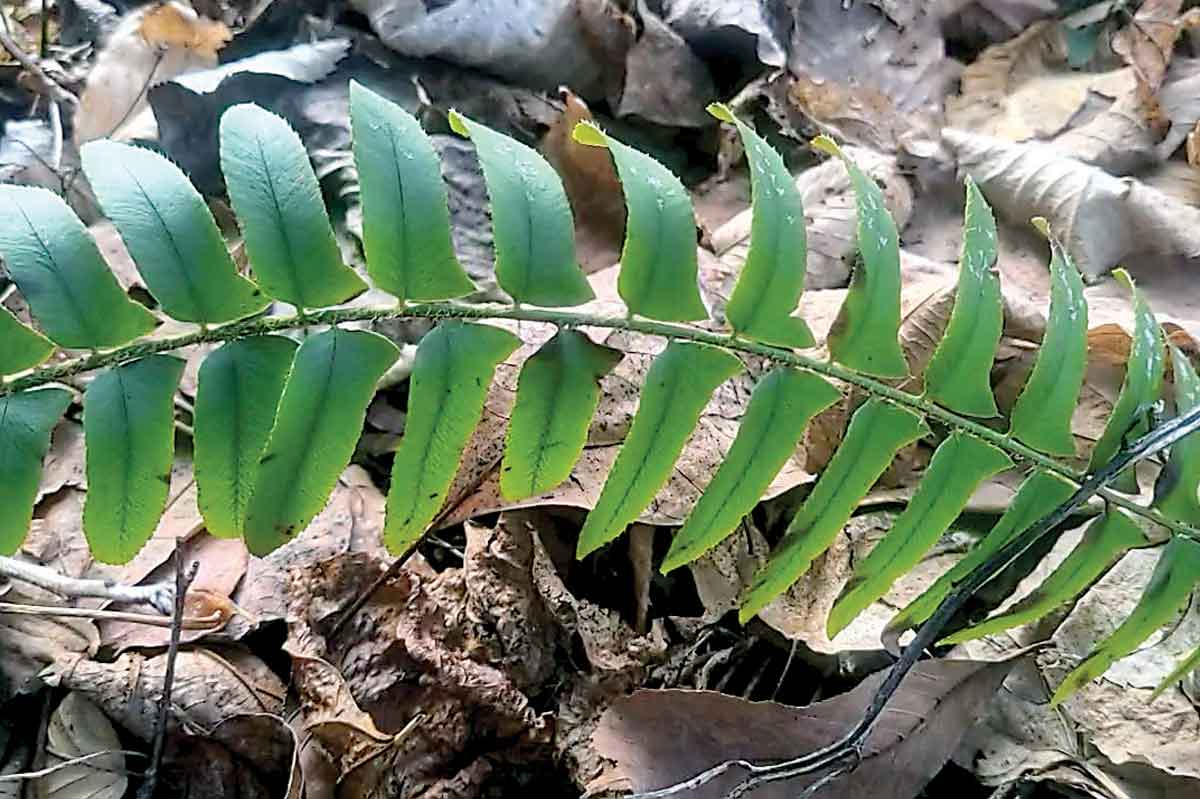Notes from a plant nerd: Happy Holly Days
 Christmas fern (Polystichum acrostichoides) is common throughout the mountain region and often used in Christmas decorations. Adam Bigelow photo
Christmas fern (Polystichum acrostichoides) is common throughout the mountain region and often used in Christmas decorations. Adam Bigelow photo
There are many different plants that Appalachian mountainfolk have used for centuries in their decorations and celebrations on or around the winter solstice.
Ferns, lycopodiums, mosses, lichens, holly and other trees, and many other native plants have been used as garlands and decorations for holiday celebrations. Among the most common Christmas trees sold is the Fraser fir (Abies fraseri) known for its soft, rounded needles which make putting on ornaments a much less painful experience than the sharp needles of spruce trees (Picea spp.)
One thing that they all have in common is being evergreen. Evergreen plants, those that do not die back to the ground and go dormant for the winter, have been celebrated as special, sacred and holy in many different cultures for thousands of years. Celtic, Druid and other Pagan European peoples, where many of our modern Christmas traditions were derived, saw magical symbolism in plants that could not only survive the long, dark and cold winters, but would thrive through them.
There is a story from the traditions of Cherokee people that tells how all the plants and trees were tasked with staying awake for seven days and nights when they were first created. Most of them were not able to do so and ended up falling asleep. Those who were able to stay awake were celebrated and gifted the power to remain green all winter long. This is why most plants go dormant and lose their leaves, since most of them fell asleep. Balsam trees, pines, cedars, hollies, laurels, hemlocks and many others were rewarded by becoming evergreen.
Evergreen plants have an advantage in gathering sunlight and energy over deciduous plants in the winter and early spring. On days where it is warm enough, they can gather sunlight and perform photosynthesis. Other times, however, they must protect themselves against the cold. Evergreen plants have developed different methods of doing so. Trees like pines (Pinus spp.) and hemlocks (Tsuga spp.) have multiple, small leaves we call needles that highly reduce the surface area of the leaves. This helps reduce water loss and limit cold exposure. Other, mostly low-growing plants like ragwort (Packera spp.) and toothwort (Cardamine diphylla) have dark purple on the underside of their leaves. Dark colors absorb and hold heat, allowing it to be slowly radiated at night, helping to keep the plants alive. Rhododendrons will roll their leaves up when temperatures dip below 25 degrees, reducing surface area, and holding air in the tube that’s formed.
One native plant of southern Appalachia that has been associated with holiday celebrations and decorations is the Christmas fern (Polystichum acrostichoides). This evergreen fern is common throughout the mountains and has been used as garland for mantle and stairway decorations for as long as there have been Christmas celebrations in this area. And its holiday association has even become a fun and easy way of identifying it. Each frond, or fern-leaf has a triangular notch where it connects to the stem, known in ferns as a “rachis.” When held horizontally, this notch can be said to look like Santa riding in his sleigh. Or, when held vertically, the notch becomes where you would hang the stocking from the chimney with care.
Related Items
While the words “holly” and “holy” aren’t truly related, they sound enough alike that I tend to associate one with the other. And with their dark green leaves and red berries, the connection with Christmas and the holiday season deepens even more as red and green are the traditional colors of Christmas. This time of year brings forth many different holidays from many different traditions, religions and different parts of the world in the northern hemisphere. Most, if not all these holidays have a connection to the natural world, to the length of the day and night, and to plants. No matter what and how you celebrate, I hope you find warmth, comfort and light in this period of cold and darkness. And remember that no matter how long and dark the winter, the wildflowers will come back.
(Adam Bigelow lives in Cullowhee and leads weekly wildflower walks and ecotours through Bigelow’s Botanical Excursions. This email address is being protected from spambots. You need JavaScript enabled to view it..)









